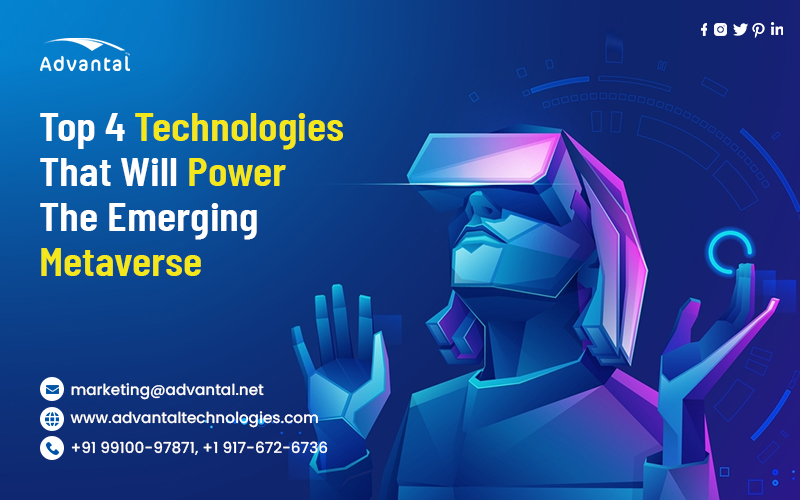AR/VR Development is paving the way for Metaverse, a parallel world where humans will immerse and have a digital identity and life. But there are more technologies involved than just extended reality technologies creating the new digital universe.
Humans dwelling in virtual digital worlds has been an intriguing sci-fi concept for authors and filmmakers for a long time. In Stanley Weinbaum’s Pygmalion’s Spectacles, the protagonist uses a set of goggles that enable sight, sound, taste, smell, and touch to explore a fictitious world.
Neil Stevenson was the first author to use the term Metaverse for the first time in his novel Snow Crash in 1992, a story about a dystopian future. Metaverse serves as an escape for those seeking relief from their bleak reality.
After 30 years of the novel, Metaverse is now becoming a reality. Last year in October, Facebook changed its name to Meta with the focus of creating a Metaverse – a 3D digital immersive world. In Metaverse, you can shop for NFTs, hang out with friends in virtual clubs and cafes, have VR office meetings, and play AR and VR games, among other things.
What Are the Technologies Involved in The Development of Metaverse?
The technologies that power Metaverse are not just XR technologies like Augmented Reality (AR), Mixed Reality (MR), and Virtual Reality (VR). It also involves other frontier technologies such as 3D reconstruction, Blockchain, Artificial Intelligence (AI and Machine Learning), and Internet of Things.
Extended Reality Technologies (AR/VR Development)
AR and VR technologies are the portals through which the users can enter the immersive world of Metaverse.
The use of augmented reality and virtual reality demonstrates an early metaverse model. Virtual reality is already producing a digital world filled with avatars and fictional elements.
Virtual reality will broaden the metaverse experience to include physical simulation via virtual reality equipment such as VR headsets (Oculus, HTC, etc.), VR gloves, among other devices. Users from different physical locations can meet and talk at one digital address.
On the other hand, AR contact lenses will augment the natural reality in our surroundings with digital elements.
We can anticipate more companies to invest in building AR and VR gear in the near future to become a stakeholder in the Metaverse.
Blockchain Technology
Blockchain Technology (including Cryptocurrency and NFTs) drives the economy within the Metaverse. In this new online world, the distributed blockchain ledgers serve as the evidence of transactions and ownerships.
Cryptocurrencies allow individuals to exchange value while working and communicating in the 3D digital environment. You may, for instance, use cryptocurrency to buy virtual land on Decentraland. With the MANA cryptocurrency, players can purchase plots in the form of NFTs. The ownership of these virtual territories will be formed and protected thanks to blockchain technology.
Artificial Intelligence
AI technology can help us streamline the creation of Metaverse assets, such as characters, landscapes, and structures, among other things. IoT (Internet of things) technology can help collect and communicate data to AI machines to process and infer conclusions.
These elements in a Metaverse game are called NPCs (or Non player characters). AI can help create these NPCs, which are a part of the environment and respond to the player’s actions. AI can help to make their interaction with the avatars realistic and more intriguing.
AI can also help in creating perfect avatars for human users. It can also design different expressions, outfits, hairdos, and actions to enhance the immersive feeling of the Metaverse environment.
Artificial Intelligence machines can create new digital ambiances, do natural language processing and translation, and make experiences more inclusive with image recognition and voice command for visually impaired users.
3D Digital Reconstruction
Computer-generated three dimensional reconstruction is not a new technology. However, the real estate industry used it intensively during the lockdowns so that people can see and experience properties remotely before buying them. Now, the technology will be included in Metaverse to enhance its capabilities.
Through 3D modeling tools, like Blender, businesses can create assets in the Metaverse. Infact, it is now possible to reconstruct objects through sensors. Mobile devices with infrared depth scanners, such as the iPhone’s LiDAR sensor, can help in some cases. It can help in the ‘digitization’ of objects for use in digital environments.
Digitization of items has the potential to benefit manufacturing industries as well. Clients can see where a product originates from and how it’s processed thanks to 3D technology. Along with AI, 3D modeling technology can help create and animate digital avatars and objects.
Conclusion
Although Metaverse is still in its nascent stages of development, several organizations are already exploring its possibilities. In the crypto realm, noteworthy projects include Decentraland and The Sandbox, but major corporations such as Microsoft, Nvidia, and Facebook are also participating. We can expect fascinating features in these borderless virtual worlds as extended reality technologies, AI, IoT, and hardware technologies improve.

